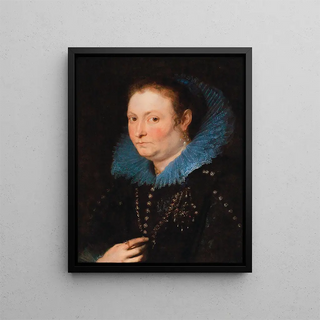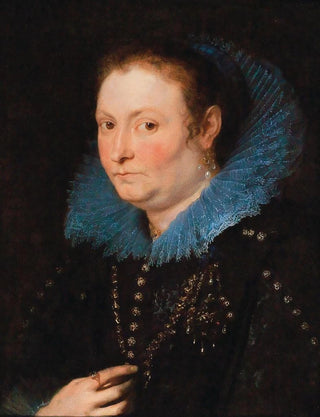Art print | Portrait of a lady half-length, considered a Genoese noble - Antoine van Dyck


View from behind

Frame (optional)
Portrait of a Lady in Half-Length, Considered a Genoese Noble - Antoine van Dyck – Captivating Introduction
The "Portrait of a Lady in Half-Length, Considered a Genoese Noble" by Antoine van Dyck is an iconic work that embodies the essence of Baroque portraiture. Created in the 17th century, this painting is not merely a simple depiction of an aristocrat; it evokes an entire era, a time when art and nobility intertwined to give birth to timeless masterpieces. Through the penetrating gaze and elegant posture of the lady, Van Dyck manages to capture the very essence of dignity and grace, making this piece a must-have for art and history enthusiasts.
Style and uniqueness of the work
The uniqueness of this piece lies in the delicate treatment of textures and colors. Van Dyck, master of portraiture, employs a subtle palette that highlights the delicate skin of the Genoese noblewoman as well as the rich fabrics of her gown. Every detail, from the draping of the clothing to the sparkle of the jewelry, is carefully crafted to create an impression of depth and realism. The composition, focused on the face and bust of the lady, immediately draws the eye and invites attentive contemplation. The artist skillfully plays with light and shadow, accentuating her features while imparting an atmosphere of mystery and sophistication. This portrait is not only a reflection of outer beauty but also an exploration of identity and social status, recurring themes in Van Dyck's work.
The artist and his influence
Antoine van Dyck, a pupil of Rubens, forged a distinctive artistic identity, leaving his mark on the European art scene. His style, combining elegance and emotion, influenced many artists across the centuries. As a court portraitist, he captured the personalities of his subjects with unmatched finesse, making each portrait unique. Van Dyck also played a crucial role in establishing portraiture as a major genre in Western art, and his influence is still felt today. Contemporary artists continue to draw inspiration from his ability to convey the

Matte finish

View from behind

Frame (optional)
Portrait of a Lady in Half-Length, Considered a Genoese Noble - Antoine van Dyck – Captivating Introduction
The "Portrait of a Lady in Half-Length, Considered a Genoese Noble" by Antoine van Dyck is an iconic work that embodies the essence of Baroque portraiture. Created in the 17th century, this painting is not merely a simple depiction of an aristocrat; it evokes an entire era, a time when art and nobility intertwined to give birth to timeless masterpieces. Through the penetrating gaze and elegant posture of the lady, Van Dyck manages to capture the very essence of dignity and grace, making this piece a must-have for art and history enthusiasts.
Style and uniqueness of the work
The uniqueness of this piece lies in the delicate treatment of textures and colors. Van Dyck, master of portraiture, employs a subtle palette that highlights the delicate skin of the Genoese noblewoman as well as the rich fabrics of her gown. Every detail, from the draping of the clothing to the sparkle of the jewelry, is carefully crafted to create an impression of depth and realism. The composition, focused on the face and bust of the lady, immediately draws the eye and invites attentive contemplation. The artist skillfully plays with light and shadow, accentuating her features while imparting an atmosphere of mystery and sophistication. This portrait is not only a reflection of outer beauty but also an exploration of identity and social status, recurring themes in Van Dyck's work.
The artist and his influence
Antoine van Dyck, a pupil of Rubens, forged a distinctive artistic identity, leaving his mark on the European art scene. His style, combining elegance and emotion, influenced many artists across the centuries. As a court portraitist, he captured the personalities of his subjects with unmatched finesse, making each portrait unique. Van Dyck also played a crucial role in establishing portraiture as a major genre in Western art, and his influence is still felt today. Contemporary artists continue to draw inspiration from his ability to convey the






